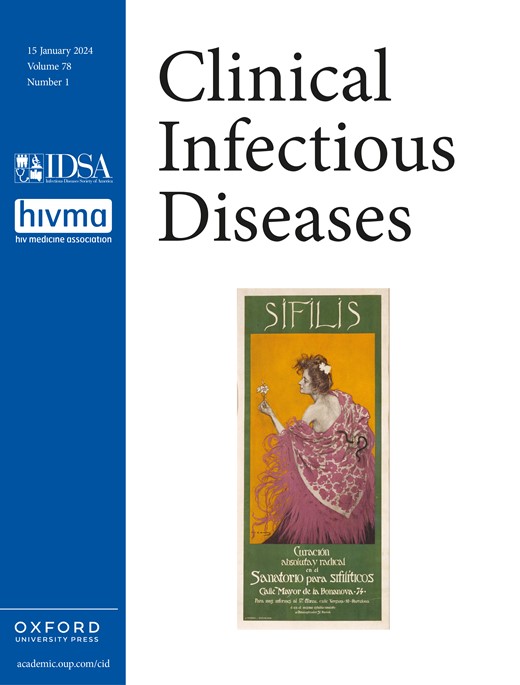加利福尼亚州接受阿片类药物使用障碍药物治疗的监禁患者丙型肝炎病毒再感染的病例对照研究
IF 8.2
1区 医学
Q1 IMMUNOLOGY
引用次数: 0
摘要
背景:被监禁者丙型肝炎病毒(HCV)感染负担过重,治疗后再次感染的风险增加。阿片类药物使用障碍(mod)的药物已被证明可以减少,但不能消除,再感染。在美国接受mod的监禁人群中,缺乏与丙型肝炎病毒再感染相关的患者水平因素的研究。方法通过对加州州立监狱在押人员健康记录的二次数据分析,开展了一项病例对照研究,这些人开始了HCV治疗,获得了持续病毒学应答(SVR),并在SVR之前开始了mod治疗。病例-患者在一年内再次感染;对照组在一年时仍为hcv阴性。结果入选对象50例;108例对照)主要为男性(96.2%),西班牙裔/拉丁裔(62.7%)或白人(29.1%),中位年龄36岁(23-60岁)。HCV再感染与注射用药独立相关(aOR=3.4;95% CI: 1.3-8.5),未消毒纹身(aOR=3.4;95% CI: 1.2-9.9),甲基苯丙胺使用(aOR=2.5;95% CI: 1.0-6.1),年龄更小(aOR=0.7;95% ci: 0.5-0.9;单位=5年),以及较低剂量丁丙诺啡(≥16mg/天)的依从性(aOR=0.7;95% ci: 0.6-1.0;单位= 0.25,aOR = 0.3;95% ci: 0.1-0.9;单位= 1.0)。结论:即使完全坚持使用mod,对丙型肝炎病毒再感染的保护作用达到70%,患者仍报告持续的危险行为。注射毒品的使用、甲基苯丙胺的使用和未经消毒的纹身也会增加其他血源性或皮肤和软组织感染和过量的风险。将加强对兴奋剂使用紊乱的监测与扩大减少危害(包括注射器服务和治疗兴奋剂使用紊乱的应急管理)相结合,可以改善健康结果。本文章由计算机程序翻译,如有差异,请以英文原文为准。
A Case-Control Study of Hepatitis C Virus Re-infection in Incarcerated Patients in California Receiving Medication for Opioid Use Disorder
Background Incarcerated people are disproportionately burdened with hepatitis C virus (HCV) infection and experience elevated risk of re-infection following treatment. Medication for opioid use disorder (MOUD) has been shown to reduce, but not eliminate, re-infection. Research is lacking on patient-level factors associated with HCV re-infection in incarcerated populations in the United States receiving MOUD. Methods We conducted a case-control study from secondary data analysis of health records among people incarcerated in California state prisons who initiated HCV treatment, achieved sustained virologic response (SVR), and began MOUD before SVR. Case-patients were re-infected within one year; controls remained HCV-negative at one year. Results Eligible subjects (50 cases; 108 controls) were predominantly male (96.2%), Hispanic/Latinx (62.7%) or White (29.1%), and median age 36 (range 23–60) years. HCV re-infection was independently associated with injection drug use (aOR=3.4; 95% CI: 1.3–8.5), unsterile tattooing (aOR=3.4; 95% CI: 1.2–9.9), methamphetamine use (aOR=2.5; 95% CI: 1.0–6.1), younger age (aOR=0.7; 95% CI: 0.5–0.9; units=5 years), and lower adherence to adequately dosed (≥16mg/day) buprenorphine (aOR=0.7; 95% CI: 0.6–1.0; units=0.25, aOR=0.3; 95% CI: 0.1–0.9; units=1.0). Conclusions Even with complete MOUD adherence, conferring a 70% protective effect for HCV re-infection, patients reported ongoing risk behaviors. Injection drug use, methamphetamine use, and unsterile tattooing also increase the risk other blood-borne or skin and soft tissue infections and overdose. Improved health outcomes could be achieved with integrating enhanced monitoring of MOUD with expanded harm reduction including syringe services and contingency management for treatment stimulant use disorders.
求助全文
通过发布文献求助,成功后即可免费获取论文全文。
去求助
来源期刊

Clinical Infectious Diseases
医学-传染病学
CiteScore
25.00
自引率
2.50%
发文量
900
审稿时长
3 months
期刊介绍:
Clinical Infectious Diseases (CID) is dedicated to publishing original research, reviews, guidelines, and perspectives with the potential to reshape clinical practice, providing clinicians with valuable insights for patient care. CID comprehensively addresses the clinical presentation, diagnosis, treatment, and prevention of a wide spectrum of infectious diseases. The journal places a high priority on the assessment of current and innovative treatments, microbiology, immunology, and policies, ensuring relevance to patient care in its commitment to advancing the field of infectious diseases.
 求助内容:
求助内容: 应助结果提醒方式:
应助结果提醒方式:


